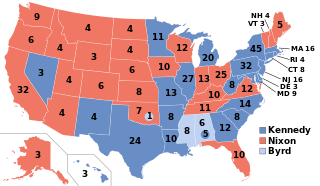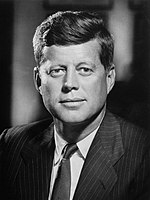
The 1960 United States presidential election was the 44th quadrennial presidential election. It was held on Tuesday, November 8, 1960. In a closely contested election, Democratic Senator John F. Kennedy defeated the incumbent Vice President Richard Nixon, the Republican nominee. This was the first election in which 50 states participated, marking the first participation of Alaska and Hawaii, and the last in which the District of Columbia did not. This made it the only presidential election where the threshold for victory was 269 electoral votes. It was also the first election in which an incumbent president –in this case, Dwight D. Eisenhower– was ineligible to run for a third term because of the term limits established by the 22nd Amendment.
In United States presidential elections, an unpledged elector is a person nominated to stand as an elector but who has not pledged to support any particular presidential or vice presidential candidate, and is free to vote for any candidate when elected a member of the Electoral College. Presidential elections are indirect, with voters in each state choosing electors on Election Day in November, and these electors choosing the president and vice president of the United States in December. Electors in practice have since the 19th century almost always agreed in advance to vote for a particular candidate — that is, they are said to have been pledged to that candidate. In several elections in the 20th century, however, competitive campaigns were mounted by candidates who made no pledge to any presidential nominee before the election. These anomalies largely arose from fissures within the Democratic Party over the issues of civil rights and segregation. No serious general election campaign has been mounted to elect unpledged electors in any state since 1964.

In the United States Electoral College, a faithless elector is an elector who does not vote for the candidates for U.S. President and U.S. Vice President for whom the elector had pledged to vote, and instead votes for another person for one or both offices or abstains from voting. As part of United States presidential elections, each state selects the method by which its electors are to be selected, which in modern times has been based on a popular vote in most states, and generally requires its electors to have pledged to vote for the candidates of their party if appointed. A pledged elector is only considered a faithless elector by breaking their pledge; unpledged electors have no pledge to break. The consequences of an elector voting in a way inconsistent with their pledge vary from state to state.
Henry D. Irwin was a Republican presidential elector for the 1960 U.S. presidential election who became a "faithless elector" when he declined to vote as pledged.

The 2004 United States presidential election in Massachusetts took place on November 2, 2004, and was part of the 2004 United States presidential election. Voters chose 12 representatives, or electors to the Electoral College, who voted for president and vice president.

The 2004 United States presidential election in Minnesota took place on November 2, 2004 as part of the 2004 United States presidential election. Voters chose ten representatives, or electors to the Electoral College, who voted for president and vice president.

The 2004 United States presidential election in Wyoming took place on November 2, 2004, and was part of the 2004 United States presidential election. Voters chose three representatives, or electors to the Electoral College, who voted for president and vice president.
Richard Nixon served as the 37th president of the United States from 1969 to 1974. He previously served as the 36th vice president of the United States from 1953 to 1961, and as a United States senator from 1950 to 1953 and United States representative from 1947 to 1950.

Electoral history of John F. Kennedy, who served as the 35th president of the United States (1961–1963) and as a United States senator (1953–1960) and United States representative (1947–1953) from Massachusetts.

The election of the president and the vice president of the United States is an indirect election in which citizens of the United States who are registered to vote in one of the fifty U.S. states or in Washington, D.C., cast ballots not directly for those offices, but instead for members of the Electoral College. These electors then cast direct votes, known as electoral votes, for president, and for vice president. The candidate who receives an absolute majority of electoral votes is then elected to that office. If no candidate receives an absolute majority of the votes for president, the House of Representatives elects the president; likewise if no one receives an absolute majority of the votes for vice president, then the Senate elects the vice president.

The 1960 United States presidential election in New York took place on November 8, 1960. All 50 states were part of the 1960 United States presidential election. Voters chose 45 electors to the Electoral College, which selected the president and vice president.

The 1960 United States presidential election in Alabama was held on November 8, 1960 as part of that year's national presidential election. Eleven Democratic electors were elected, of whom six voted for Senator Harry F. Byrd of Virginia and five for Senator John F. Kennedy of Massachusetts.

The 1960 United States presidential election in Kentucky took place on November 8, 1960, as part of the 1960 United States presidential election. Kentucky voters chose 10 representatives, or electors, to the Electoral College, who voted for president and vice president.

The 1952 United States presidential election in Oklahoma took place on November 4, 1952, as part of the 1952 United States presidential election. Voters chose eight electors to the Electoral College, who voted for president and vice president.















